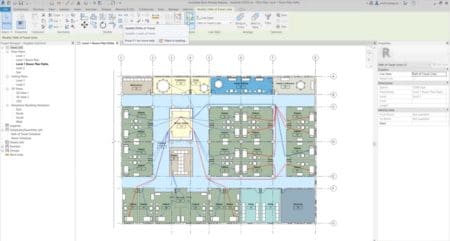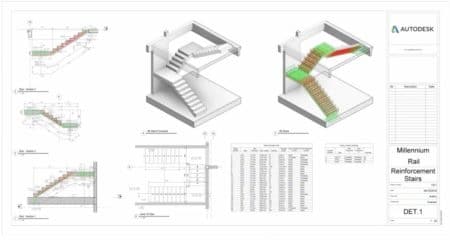Autodesk has announced the 2020 versions of flagship BIM and CAD applications in Revit, InfraWorks and Civil 3D.
Revit 2020 — What’s New
Autodesk has announced an epic release this year in Revit 2020, including both requests submitted by users through its Revit Ideas page and also introducing new features and functionality. With version 2020, all disciplines will see new tools and enhancements that help users generate consistent, coordinated, and complete model-based building designs and documentation. Here are some of the highlights—but by no means the full exhaustive list of updates—under the following categories:
Capture Detailed Design Intent
New features help you capture design intent in detailed documentation, for example:
- Electrical homerun wiring improvements — more control over arrowheads, tick marks, etc.
- New support to draw elliptical walls and curtain walls in Revit, offers designers more freedom.
- Improved rebar copy and paste — new increased precision and control for working with shape-driven rebar in models.
- New multi-rebar annotations for planar parallel free form rebar sets and concrete faces
- Rebar in model-in-place concrete stairs — new 3D modeling versatility that helps designers define more accurate reinforcement
- Propagate steel connections — new ways to save users time when they need to insert the same connection in multiple locations on a large project.
Connecting 2D Data to BIM and Beyond
This category is about collaboration at its most fundamental level and new features in Revit 2020 provide exactly that.

01 – Revit 2020 now includes a simulation tool to see how people move inside a building, useful for design performance analysis.
One of the largest demanded features is now included in Revit 2020—new support for PDF underlay. This means users can bring in 2D data in the form of PDF documents and use it in Revit with full snap support for creating model elements based on the imported PDF 2D geometries. This enables 2D data into BIM support for construction workflows.
Another new feature from the Revit Ideas page is the new support to import SketchUp files. Now support for SketchUp 2018 will allow users to bring in SketchUp models from schematic design processes or other stakeholders creating solutions in that format. There is support for colored imports that enable more effective early-stage design done in SketchUp to Revit workflows.

02 – There are substantial improvements to rebar modeling and editing, including new features that will aid designers in concrete stair design.
Coinciding with the Revit 2020 launch, Autodesk is introducing Cloud Model Upgrade. This service automates upgrading all cloud models in a BIM 360 project. This incredible feature will save users time and simplifies streaming the move to the latest version of Autodesk Revit. You can learn more about cloud models upgrade in BIM 360 here.
Automate and Optimize
This category of features aids productivity in working with Revit and helps with the ability to conduct analysis that supports decision making.
- Path of Travel — new features to simulate how people will move in the building between two points of travel.
- Dynamo 2.1 Now Ships with Revit 2020 — a new unified experience, simplifying use, installation, and versioning.
- Autodesk Steel Connections 2020 Dynamo Package — new support accelerates the insertion of multiple steel connections based on user-defined rules that can identify similar geometrical conditions for placing standard and custom connections. The package includes several out-of-the-box scripts for use with the Dynamo Player.
- Background processing benefits users in editing complex detailed steel connections.
- Schedule elevations for elements (like ductwork) and use those values in view filters.
These are some of the major new features in the new Revit 2020 release. To learn more you can read the complete list of new features and improvements here. Visit the Autodesk Revit page here to learn more about this leading BIM application.



Reader Comments
Comments for this story are closed